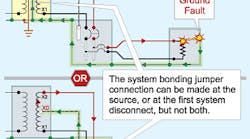All questions and answers are based on the 2008 NEC.
Q. Can I connect the neutral conductor to the equipment-grounding terminal at both the transformer and the first disconnect?
A. No. The NEC requires the neutral conductor of a transformer that meets the definition of a separately derived system to be connected to the equipment-grounding conductor at the transformer or the disconnecting means or overcurrent device on the secondary — but not at both locations [250.30(A)(3)]. The connection of the neutral conductor to the equipment-grounding conductor is called a system bonding jumper, and it provides a low-impedance fault current path to the power supply to facilitate the clearing of a ground fault by opening the circuit overcurrent device. For more information, see 250.2, 250.4(A)(5), 250.28, and 250.30(A)(1), as shown in the Figure.
Caution: Dangerous objectionable neutral current will flow on conductive metal parts of electrical equipment as well as metal piping and structural steel, in violation of 250.6(A), if more than one system bonding jumper is installed. Objectionable neutral current on metal parts can cause electric shock, fires, and improper operation of electronic equipment and overcurrent devices such as GFPs, GFCIs, and AFCIs.
Q. Can a single transfer switch be used to supply two separate panels?
A. It depends on the type of loads the panels serve. Emergency lighting or another load that the AHJ deems “emergency” (Art. 700) must be supplied by its own separate transfer switch [700.6(D)]. Legally required standby and/or optional standby system loads are permitted to be supplied by a single transfer switch.
Q. What are the disconnect requirements for appliances, such as dishwashers, in a dwelling unit or a hand dryer in a restaurant?
A. Each appliance requires a means of disconnect [422.30]. A unit switch with a marked “off” position that is a part of the appliance can serve as the appliance disconnect, if it disconnects all ungrounded conductors [422.34]. If a unit switch is not provided on the appliance, then a switch or circuit breaker located within sight from the appliance can serve as the appliance disconnecting means, unless the switch or circuit breaker is capable of being locked in the open position [422.31(A)].
Q. I'm confused. When must I use a 4-wire cord for dryers and ranges?
A. The frames of electric ranges, wall-mounted ovens, counter-mounted cooking units, clothes dryers, and outlet boxes that are part of the circuit for these appliances must be connected to the equipment-grounding conductor (4-wire cord/receptacle) [250.134(A) and 250.140].
Caution: Ranges, dryers, and ovens have their metal cases connected to the neutral conductor at the factory. This neutral-to-case connection must be removed when these appliances are installed in new construction, and a 4-wire cord and receptacle must be used [250.142(B)]. For existing installations where an equipment-grounding conductor isn't present in the outlet box, the frames of electric ranges, wall-mounted ovens, counter-mounted cooking units, clothes dryers, and outlet boxes that are part of the circuit for these appliances may be connected to the neutral conductor (3-wire cord/receptacle) [250.140 Ex].
Q. What are the grounding and bonding requirements for a hydromassage bathtub?
A. If the building contains a metal piping system, it must be bonded with a solid copper equipotential bonding jumper, sized not smaller than 8 AWG, to the circulating pump (if it's not double insulated), and to any other grounded metal parts that contact the circulating water. The bonding is to be done at the location of the motor. This equipotential hydromassage bonding jumper is not required to be connected to any remote panelboard, service equipment, or electrode [680.74].
Q. After driving two ground rods, we still can't get the ground resistance to be 25 ohms or less. What do we do?
A. The NEC does not require that you achieve a 25-ohm ground resistance if you have two ground rods, so call it a day. The rule is that when the grounding electrode system consists of a single ground rod having a contact resistance to the earth of more than 25 ohms, it must be augmented with an additional electrode located not less than 6 feet away [250.56].




